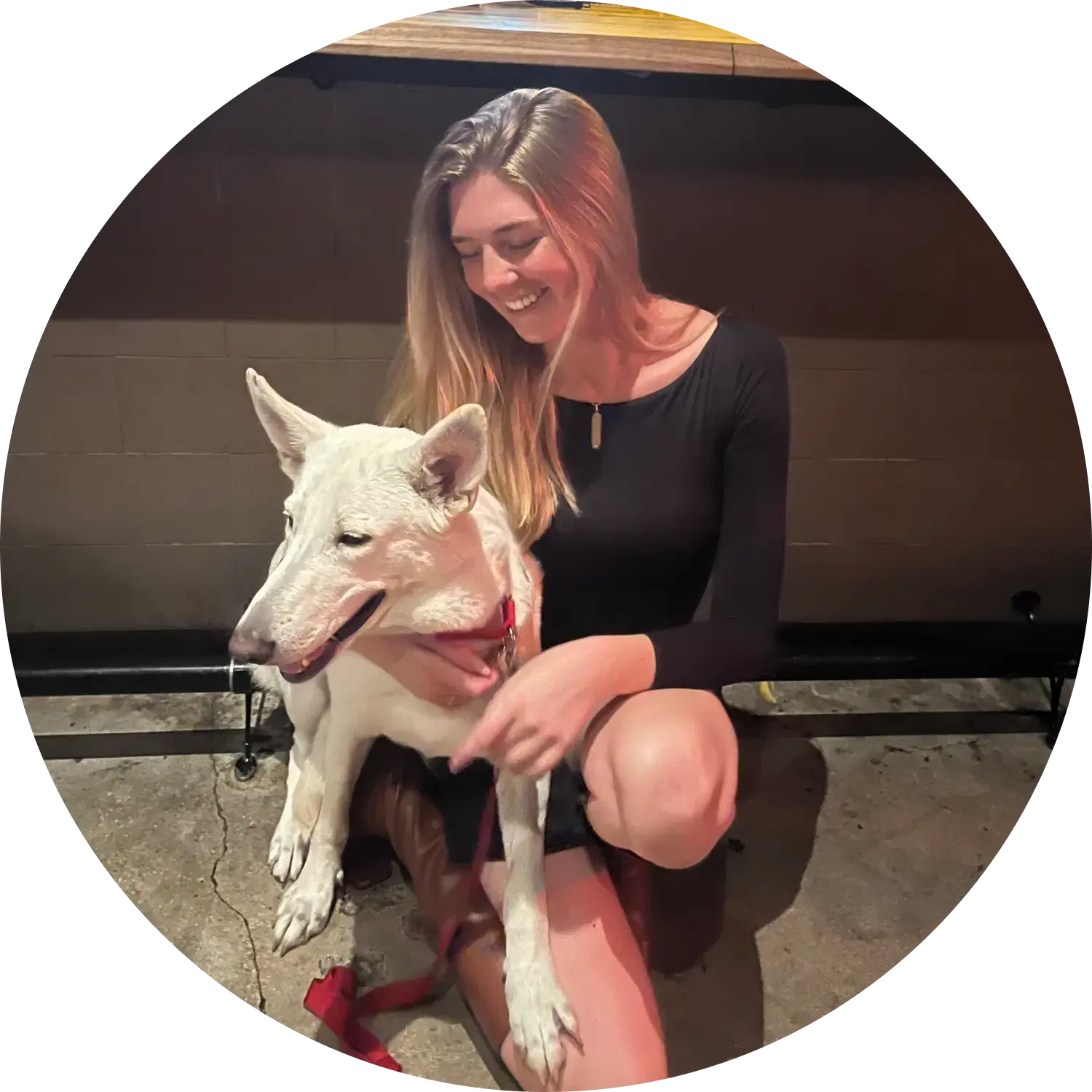The first set of teeth, the incisors, begin to come out at the age of 2-4 weeks. By the time the pup is 5-8 weeks old, all of the 28 baby teeth are out. (1)
It’s funny that you want to know when your adorable little fluffball will grow razor-sharp teeth that seem to have a personal vendetta against your fingers, furniture, and favorite shoes. But it shows that you’re a good pet parent and want to do everything possible to help your little pup in their developmental journey.
And we’ll help you with it.
Puppies and Teeth: A Timeline
Puppies go through two phases of teething during their developmental stage –
Phase 1 – Eruption
Puppies are born without teeth. Their mouth doesn’t remain empty for long, though.
2-4 weeks – In the first month, you may see the first set of baby teeth emerge, starting with the incisors. (1)
5-8 weeks – By month 2, all 28 baby teeth usually develop. (1)
Pet parents don’t usually get to see this phase as the pups are with their mothers during this time. It is recommended that you wait until the pup is 8 weeks old before you bring them home. (2)
Phase 2 – Adult Teeth
This is a more noticeable phase that typically begins once the pup is about 3 months old.
3-4 months – You’ll see the baby teeth falling out here as the adult ones begin to emerge. (1)
4-6 months – These 2-3 months are the peak time when most of their adult teeth come in. (1)
6-7 months – By this time, the pup would have developed all of their 42 adult teeth. (1)
According to a study published in the Journal of Veterinary Dentistry, 87% of puppies have all their adult teeth by 7 months of age. (3)
While we’ve told you about the timeline, apart from the obvious signs of your pup teething, you must know other signs that indicate the teething process in them. This will help you understand them better and provide timely support whenever needed.
What are the Signs of Teething in Puppies?
Excessive chewing – as puppies seek relief from the sore gums
Drooling – because of increased saliva production in the mouth
Blood spots on their toys – in case the pup has swollen and bleeding gums
Reluctance to eat – especially for hard kibble, as it may get uncomfortable for them
Excessive whining – you may see a change in the pup’s behavior as the pain can sometimes make them irritable
Gaps in teeth – when their baby teeth fall out
A survey found that 78% of puppy parents saw excessive chewing as the primary sign of teething. (4)
You see that while teething is a natural process for pups, it can be painful and uncomfortable for your puppy. We’ve all had teeth problems. We know how horrible they can be. It's important to take appropriate steps to help manage your puppy's discomfort during this phase.
How to Manage a Puppy’s Discomfort while Teething?
Here are some effective tricks to help your puppy while they're teething – (5)
Get some appropriate chewing toys
There are some available in the market that are specially designed for teething pups. Make sure they are soft but durable enough to withstand persistent chewing. They are usually textured to massage their gums.
Cold therapy
Remember when your dentist used to advise you to eat an ice cream after a dental cleaning or root canal? That’s because cold can help soothe sore gums. You can try freezing a damp cloth and offering it to the pup to chew on.
Diet adjustments
Hard kibble can be difficult to chew on during peak teething. Try softening dry kibble with warm water. You could even opt for wet food temporarily. Make sure they are hydrated at all times.
Dental hygiene
As the pup starts growing teeth, you’ll have to develop a dental hygiene routine. The earlier you start, the better it is. Get a gentle toothbrush and a puppy-safe toothpaste. (Never use the ones made for humans). Use dental wipes to clean their gums.
And if it isn’t obvious enough, please avoid games like Tug of War during their teething phases. You’ll not only end up giving them a lot of pain but also risk losing their teeth.
We know that you will do everything to take care of your pup during their developing stages (and of course after as well). However, despite everything, you may face certain issues.
Common Concerns While Puppy Teething
Some problems that you may encounter during your pup’s teething phase are: (6)
Retained baby teeth
Excessive chewing on inappropriate items
Increased aggression and irritability
If you do face these issues, especially retained baby teeth, you should take the pup to the vet. If not treated, it can create severe dental problems later. You should consult your vet if you see the following: (6)
Severely swollen or bleeding gums
Significant weight loss
Misaligned adult teeth
Persistent retained baby teeth
Congratulations! You are now a pet parent with more knowledge about your pet and their health. You’ll be able to provide them with comfort when they need it. With a proper dental hygiene routine, you’ll be able to prevent many dental problems for your pup.
However, sometimes, despite your best efforts, dogs can be affected by certain dental problems. It can be infections or broken teeth, or it could even be cancer. And we all know that dental treatments can be expensive.
Here are some figures to give you an idea -
How much does Dental Care for Dogs Cost?
A basic dental cleaning can cost anywhere between $100 and $200. But if the cleaning is followed by a treatment, the costs can be much higher. Below are some examples - (7)
Extraction - $25-$100 per tooth (7)
Root Canal (for a fractured tooth) - $4,000-$4,500 (10)
Periodontal Disease - $500-$5,000 for anesthetic dental cleanings(11)
If your dog needs anesthesia, you can expect to spend around $200-$300 more on the surgery, depending on the complication. Apart from these, there may be some diagnostic costs attached. Pain medications would cost you around $40-$80. X-rays typically cost around $250. Bloodwork will cost you around $100-$150. (7)
These numbers can be enough to make a big dent in your bank account.
About 80% of the dogs develop some form of periodontal disease by the time they are three years old. (9)
Pet insurance - You can save up to 90% of the costs related to medical and dental treatments for your pup. With Spot Pet, you can even save costs on dental cleanings with a preventive care add-on.
More about Spot Pet Insurance
Dog Insurance can help provide financial assistance for eligible veterinary care in case of unexpected accidents, illnesses, or injuries. Our plans can help pet parents manage the eligible costs of covered veterinary care and help ensure that their pets can receive the best treatment possible. Here are some ways that Spot pet insurance plans can help:
Covers Unexpected Veterinary Costs: Spot pet insurance plans help cover the eligible costs of unexpected veterinary treatments, such as emergency surgeries, X-rays, and prescription medications for covered conditions.
Customizable Plans: Choose your annual limit, reimbursement rate, and deductible from a range of options, and create the plan that will fit the needs of your pet and your budget.
Peace of Mind: With Spot pet insurance plans, pet parents can know that they can provide the best care for their pet with less worry about the cost.
To learn more about Spot Plans or to get a free quote, click here.

The resident animal enthusiast at Spot. I have a lifetime of pet parent experience. If it has fur, feathers, or scales, I’ve probably shared my home with it. I aim to be a reliable source, blending experience with a dedication to the well-being of pets.
Myers, J., & Myers, J. (2024, May 1). Puppy teething: a guide to the teething process. Vetster Online Vets. https://vetster.com/en/wellness/puppy-teething-a-guide-to-the-teething-process
Work, P. I. (2023, October 5). When can I bring my puppy home? Paws in Work. https://www.pawsinwork.com/blog/whats-the-perfect-age-to-rehome-your-puppy
Expert, P. P. (2024, September 3). Puppy Teething: Everything you need to know. Purina US. https://www.purina.com/articles/dog/puppy/health/puppy-teething
Puppy teething: Stages, symptoms, and solutions | Nylabone. (n.d.). https://www.nylabone.com/dog101/puppy-teething-stages-symptoms-solutions
Puppy teething guide | Lily’s Kitchen. (2024, November 4). Lilys Kitchen. https://www.lilyskitchen.co.uk/pet-care/caring-for-your-dog/healthy-dogs/puppy-teething-rory-the-vet.html
MeganM. (2024, December 18). Puppy Teething 101 - Lake City Animal Hospital. Lake City Animal Hospital. https://lakecityanimalhospital.com/blog/puppy-teething/
3. Taffer, M. (2024, September 20). How much does it cost to remove a dog’s tooth? Betterpet - Advice From Veterinarians and Actual Pet Experts. https://betterpet.com/dog-tooth-extraction-cost/
4. Steere, K. (2021, December 23). Budgeting for pet dental costs: vet bills, insurance & more. Pawlicy Advisor. https://www.pawlicy.com/blog/pet-dental-cost-budget/
Periodontal disease. (n.d.). Cornell University College of Veterinary Medicine. https://www.vet.cornell.edu/departments-centers-and-institutes/riney-canine-health-center/canine-health-information/periodontal-disease
WhiskerTeam. (2025, March 5). Pet root canal treatment in Mill Valley, CA | Aggie Animal Dental Center. Aggie Animal Dental Center. https://aggievetdentist.com/pet-root-canal-treatment-mill-valley-ca/
Grenus, B., DVM. (2024, March 26). Periodontal disease in dogs. PetMD. https://www.petmd.com/dog/conditions/mouth/periodontal-disease-dogs












